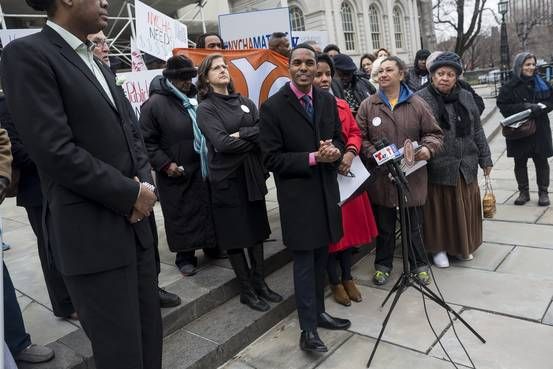
Housing Starts: Greening Public Housing | No Landmark Bill After All | Multifamily Meltdown Coming?

Ritchie Torres of City Council rallies for public housing funding (Photo Credit: Keith Bedford for the Wall Street Journal)
- New York Plans Upgrades for Housing Projects to Reduce Emissions and Utility Costs Mayor Bill de Blasio, along with Julián Castro, secretary of the federal Department of Housing and Urban Development, announced on Thursday a plan to install $100 million worth of alterations and improvements to make buildings in some 300 public housing developments more efficient. The measures will start at 89 housing projects with 87,000 apartments, with the replacement of old boilers and lighting but could become more ambitious — perhaps even including solar panels — as utility savings are achieved, city officials said.
- Not So Fast: City Council Says There’s No Landmark Bill in the Works Manhattan Borough President Gale Brewer may have jumped the gun when she announced last week she would join with three top City Council members to draft legislation to reform the city’s landmark process. “At the speaker’s direction, the City Council legislative and land-use divisions have been working on landmarks reforms with council members, and there is no legislation being introduced at this time,” a spokeswoman for Council Speaker Melissa Mark-Viverito said.
- Elected Officials, Housing Advocates Push NYC City Hall for More More Money for Public Housing Earlier this year, Mayor Bill de Blasio asked the state to provide $300 million in funding in this year’s budget for the New York City Housing Authority, and he promised that the city would match the state allocation. The state ultimately allocated $100 million as part of the budget, and a spokeswoman for the city’s budget office confirmed Thursday that the mayor will support matching that commitment with city money. But New York City Council Member Ritchie Torres, a Democrat from the Bronx and the chairman of the council’s committee on public housing, said during a rally Thursday the mayor’s commitment is insufficient and won’t address lingering infrastructure problems.
- N.Y. Dems Plan Tax Equity Bill for High-Cost Cities Three New York Democrats plan to introduce legislation require the Internal Revenue Service to modify tax brackets for people who reside in areas where the cost of living is high. Reps. Jerry Nadler, Nita Lowey and Steve Israel announced the bill on Friday ahead of the federal tax filing deadline on April 15. Under their proposal, the IRS would account for regional cost-of-living adjustments in individual income tax rates. The Labor Department would be responsible for determining a regional cost-of-living index for metropolitan areas.
- Market Ready for First Micro Homes as Kips Bay Project Nears Completion When the term “micro units” first entered New Yorkers’ lexicon, the average rent was nearing $4,000 per month, and Mayor Bloomberg was looking to fill a gap in studio and one bedroom apartments in Manhattan. More than two years later, the first iteration of the much-discussed apartments are finally poised to become a reality. Monadnock Development, which won Bloomberg’s adAPT NYC competition back in January 2013 with its micro unit design, is nearing completion on the 55-unit My Micro NY, at 335 E. 27th Street.
- Multifamily Meltdown It is a question clanging around the minds and meetings of residential lenders this spring: What if the state repeals the decades-old 421a tax abatement? The law, a staple of New York City multifamily finance, has been renewed continually since the 1970s, but comes up for renewal this June. Such a scenario has lenders pondering a financing ecosystem steered almost exclusively toward condominiums and commercial developments such as hotels, or toward that rare development firm that could finance most of its rental project solo.
- Developers See Opportunity at Site of Seven-Alarm Fire in Williamsburg When a seven-alarm fire ripped through a records-storage warehouse on the Williamsburg waterfront in late January, most New Yorkers saw a conflagration that spewed charred medical reports, court transcripts and other decades-old scraps of paper onto city streets and sidewalks. Developers, however, saw an opportunity to build something transformative at the 11-acre property on the East River at North 11th Street, while locals saw a park promised to them a decade ago. Those competing visions have already produced conflict over the last major parcel in one of the city’s most desirable neighborhoods.
- Landlords Remain Wary of De Blasio’s War on Homelessness Mayor Bill de Blasio has launched an $11 million war on homelessness and he’s seeking to house thousands. Yet city landlords remain wary. Last month, the city began making robocalls to landlords, asking them to house homeless families from the shelter system. In the 45-second taped call, the mayor says that landlords who take him up on his offer will receive a $1,000 signing bonus.
- The Real Role of Land Values in the United States Just 6 percent of America’s nearly 2 billion acres of land is developed, Larson finds. But that little bit of land packs a substantial financial punch. It’s worth roughly $11.7 trillion, according to his calculations, comprising slightly more than half of the total value of U.S. land. Compare that to agricultural land, which accounts for nearly half (47 percent) of all land across the contiguous states but is worth just $1.8 trillion. The federal government owns 24 percent of the nation’s land area, which makes up an additional 8 percent of the country’s total land value.
- Forget Manhattan. Brooklyn’s Real-Estate Market Is on Fire — and It’s Not Cooling Off Anytime Soon. Manhattan may still think it’s the older, more established sister of sweet, charming Brooklyn, but the most recent real-estate market reports have given it a reality check. According to Douglas Elliman’s first-quarter survey released today, Brooklyn’s prices continue to break records, with the median now at $610,894, a 17.5 percent jump from 2014. (The average price, $749,269, increased by 10 percent.) Meanwhile, Manhattan saw its numbers plateau in the same period.


